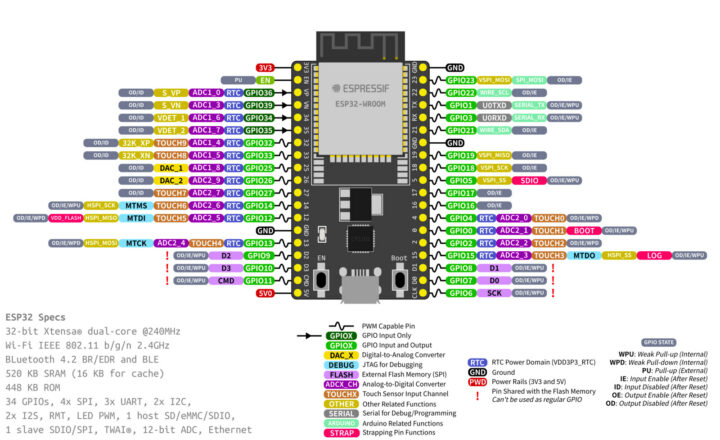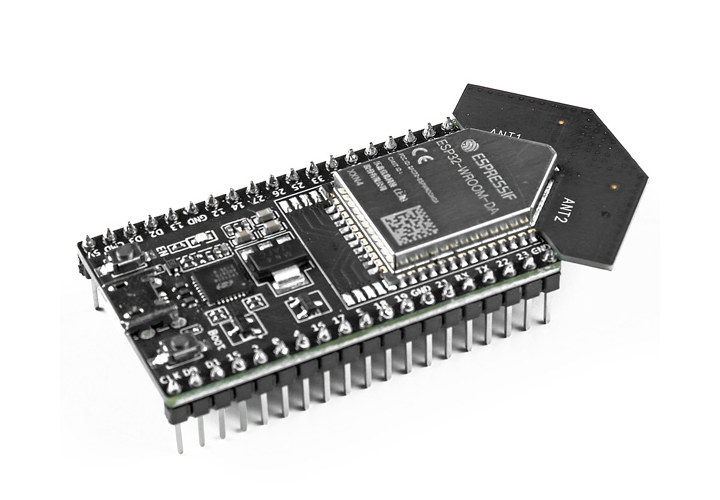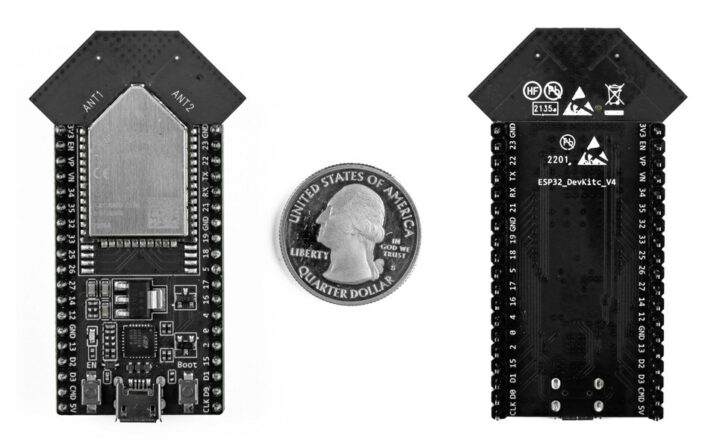The ESP32 DevKitC V4 is now selling with the ESP32-WROOM-DA module with two PCB antennas that was introduced last year in order to offer a longer WiFi range and better reliability.
The development kit is exactly the same as the other ESP32 DevKitC V4 models, and the only difference is the dual antenna design. When running a recent version of the Arduino Core for the ESP32 (2.0.3 or greater), the ESP32 will automatically switch to the antenna with the strongest signal in order to deliver the best connectivity possible.
ESP32 DevKitC V4 specifications:
- Wireless module – ESP32-WROOM-DA (PDF datasheet) with
- SoC – Espressif Systems ESP32-D0WD-V3 dual-core LX6 microprocessor with 520 KB SRAM, 2.4 GHz WiFi 4 and Bluetooth 4.1 connectivity
- Storage – 4MB SPI flash
- Two PCB antennas (ANT1 and ANT2)
- USB – 1x Micro USB port for power, programming, and debugging through USB-to-UART bridge up to 3 Mbps
- Expansion – 2x 18-pin headers with up to 34x GPIO, PWM, 12-bit ADC, DAC, 3x I2C, 4x UART, I2S, 4x SPI, etc…
- Misc – Reset (EN) and Boot buttons, Power LED.
- Power Supply – 5V via micro USB port, 5V or 3.3V via header; note: all three methods are mutually exclusive
- Dimensions – It’s complicated, but the main board measures 48.2 x 27.9 mm
You’ll notice the antenna design has changed since the first announcement with a “T” design replacing the “Snake” design that looks great on T-shirts, but I suppose there was a good reason for the change. You’ll find the documentation to get started with the ESP-IDF framework on Espressif’s documentation website.
Sparkfun notes that “not all pins are broken out and some have more than one role” and specifically “the pins D0, D1, D2, D3, CMD and CLK are used internally for communication between ESP32 and SPI flash memory”, so you should avoid using those. It’s the same story for all ESP32 DevKitC V4 variants.

You can check out the WiFiScanDualAntenna.ino sketch to test antenna switching. Andreas Spiess tested the ESP32-WROOM-DA module last April and found the dual antenna module does perform better than the single antenna modules and noted a good antenna design may even help lower the power consumption.
Sparkfun is selling the ESP DevKitC V4 development board with ESP32-WROOM-DA for $14.95, or you could also get the module only for $5.95. If you live outside the US, you should also be able to purchase from a local distributor to lower the shipping fee, and potentially avoid extra paperwork to comply with US export requirements.
As a side note, the Espressif DevConf 2022 will take place on October 19-20, and anybody interested can register for free.
Via ThaiEasyElec (which sells the module in Thailand for 790 THB)

Jean-Luc started CNX Software in 2010 as a part-time endeavor, before quitting his job as a software engineering manager, and starting to write daily news, and reviews full time later in 2011.
Support CNX Software! Donate via cryptocurrencies, become a Patron on Patreon, or purchase goods on Amazon or Aliexpress







This kind of device could also be very interesting with dual antenna connector to be able add a long wire arround a thick wall and spread the signal on both sides of it.
Keep in mind that the co-ax used with the tiny connectors you find on these kinds of boards has a lot of loss. If you run it further than a few feet, you might as well not even attach it.
Even as someone with a few decades of RF experience, I have no idea what’s up with that antenna. I assume they made the change because this design allows them to have the most orthogonality between the two antennas. This means that the two antennas “see” RF as differently as possible–it’s not quite that, but it’s a hard concept to explain. Smaller antennas act more and more like (low gain) omnidirectional devices, so it’s very hard to make two tiny antennas that “see” RF differently as they both act omnidirectionally. The antenna design here must be something that acts as… Read more »
The dual antennas provide some diversity to mitigate multipath fade. It would be interesting to see the polar radiation plots.
I think he talked about the new T-shape vs old Snake-shape design. Why did they change it?
They’re supposed to offer some diversity, but antennas that small don’t diverge much from isotropic radiators (and bad ones at that). At best they have a decent null. If that’s what they’re combating, then this board doesn’t bring much to the table as a null can simply be aimed in a useless direction (up or down). A board like this with *just* antenna connectors would be much more useful. But, as you said, I’d really like to see their plots to see what’s the reason to go with this antenna design. For people not into RF, the issue here is… Read more »
Antenna design is part science and part magic lol.
@Jean-Luc Aufranc said: “As a side note, the Espressif DevConf 2022 will take place on October 19-20, and anybody interested can register for free.” The daily schedules are listed on the Espressif DevCon22 web page. I live on the U.S. East Coast, so in order to participate in Espressif DevCon22 I am going to have to get up pretty early in the morning. Where I live we are currently on Eastern Daylight Time (EDT) which is UTC-4 hours.[2] The conference schedule is in Central European Summer Time (CEST) which is UTC+2 hours.[3] So the time difference between EDT and CEST… Read more »
bruh
When will we start seeing some 5g boards in the small esp32 form factor. I see plans for the c5 but haven’t heard much other than just that, plans.